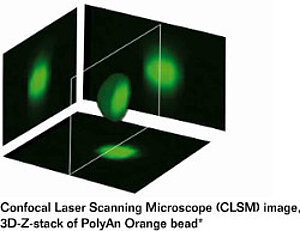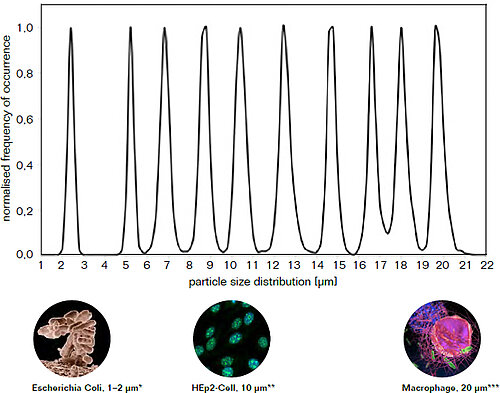Micro- and Nanoparticles
PolyAn is offering a portfolio of monodisperse PMMA (poly methyl methacrylate) particles for multiplex bead assays, calibration of flow cytometers and calibration of fluorescence imaging systems as well as a wide range of other applications in LifeScience research. PolyAn’s non-porous particles are comprised of a PMMA core with a 3D surface modification:
- Fluorescence encoded beads for multiplex bead assays
- Fluorescence encoded beads for standardisation and calibration (SCB Microbeads and SCB Nanobeads)
- Calibration slide for fluorescence imaging systems
- Counting beads for calibration of cytometry systems
- Fluorescence lifetime encoded beads
- Transparent PMMA beads (microparticles)
- Functionalized, transparent PMMA beads (microparticles)
- Functionalized fluorescence encoded beads
- Fluorescence encoded PMMA-Nanobeads (carboxylated, aldehyde modified)
- Hydrophobic beads


PolyAn’s microparticles can be color-encoded with up to six fluorescent dyes. The fluorophores are directly incorporated into the core of the bead during the microparticle formation. This ensures a much more homogeneous distribution of the dyes within the beads when compared to conventional diffusion controlled dyeing processes. Additionally, the fluorophores are caged within the polymeric PMMA matrix and thus less likely to leak-out. The homogenous distribution of fluorophores is illustrated in the adjacent CLSM image.
PolyAn’s microparticles are functionalized using our proprietary Molecular Surface Engineering (MSE) Technology. PolyAn’s reactive matrices are suitable as a platform for a wide range of coupling methods. Our microparticles are characterized by low non-specific adsorption and low aggregation behaviour.
While we publish an overview of our products, it is by no means comprehensive. If the particle you require is not listed, we urge you to contact us to check our complete inventory. Please note, that we also offer a customization service for your specific application.
Microparticle Characteristics
Base material
Our polymer microparticles are based on a PMMA (poly methyl methacrylate) core with a covalently bound reactive 3-dimensional surface.
Using PMMA ensures an excellent optical brilliance and a low autofluorescence compared to other microparticle materials. The refractive index of 1.48 is close to the refractive index of cells (ca. 1.38). Our microparticles have a density of 1.18 g/cm³ and a glass transition temperature (Tg) of about 110°C. PolyAn’s PMMA is biocompatible.

* Image courtesy of Bundesanstalt für Materialforschung und -prüfung

Size and size distribution
PolyAn produces microparticles in the range between 2 - 20 µm. Each bead population is monodisperse with a maximum Coefficient of Variation (CV) of less than 5%.
For applications that require smaller bead sizes, PolyAn also offers PMMA submicron particles in the size range between 100 nm - 500 nm.

Image sources:
*Agricultural Research Service, Wikimedia Commons, **Medipan GmbH, ***Universität Potsdam
